
Ancient cave drawings and hieroglyphics both used line art, which has a long and illustrious history. Throughout the ages, the method changed and developed, eventually becoming a fundamental component of many different kinds of art, such as painting, illustration, comics, and graphic design. Line art, however, did not significantly change until the advent of digital technology.

With the advent of digital technology, the art world has undergone a revolution, becoming more approachable, effective, and versatile. It has given artists new resources and methods for producing works of art that were previously impossible. In the case of line art, the switch from pen to pixel has resulted in a number of changes that have had a significant impact on the art form.

Digital line art has a lot of flexibility, which is one of its biggest benefits. Digital line art, in contrast to traditional line art, can be produced using a variety of software tools that provide more control, accuracy, and convenience. Traditional line art requires the use of physical tools like pens, brushes, and paper. To produce line art that is more streamlined, intricate, and adaptable, artists can use digital drawing tablets, styluses, and software applications like Adobe Illustrator, Procreate, or Clip Studio Paint.

One more benefit of digital line art is how simple it is to edit and revise. Errors in traditional line art frequently remain permanent and are difficult to fix. Digital line art, on the other hand, allows artists to quickly and easily edit their work, fix errors, or try out new colors, textures, and effects. Many artists prefer digital line art because of its versatility, particularly those who work in commercial fields where meeting deadlines and receiving client feedback are common.
Additionally, the use of line art in various contexts and media has become more accessible thanks to the digital age. Today, line art is used for a variety of purposes, including animation, motion graphics, web design, and game development. Using it to produce distinctive and memorable visuals has become a crucial component of branding, advertising, and marketing campaigns.
Line art has faced some difficulties with the switch from pen to pixel, though. The loss of traditional line art's physicality and tactile experience is one of the biggest worries. Digital line art can come off as sterile or manufactured because it lacks the depth, texture, and personality of hand-drawn art.
Another issue is the potential overuse of digital tools and automation, which can make it simple for artists to become dependent on software and lose their ability to draw by hand. In order to maintain the integrity and authenticity of the art form, some artists have taken up the cause of balancing digital and traditional techniques.
In conclusion, the switch from pen to pixel has significantly altered line art. It is now easier to use, more adaptable, and efficient thanks to digital technology, which has also created new opportunities. It has, however, also brought about some difficulties, such as the loss of tactile experience and the potential over-reliance on automation. Despite these difficulties, line art continues to be a vital and dynamic art form that thrives in the digital age.
